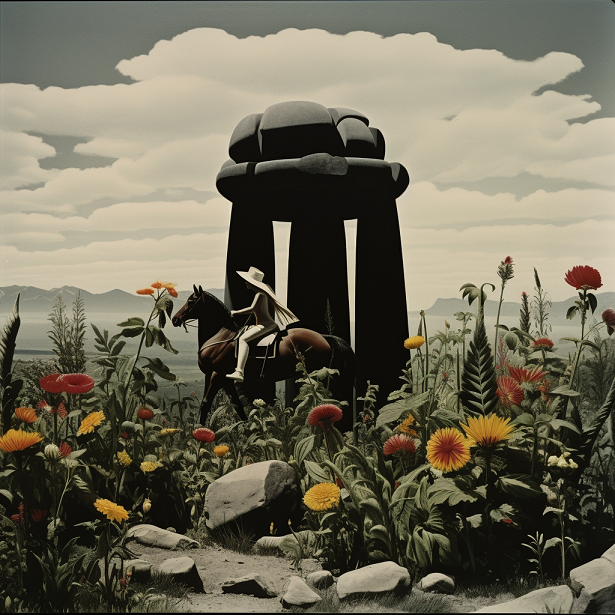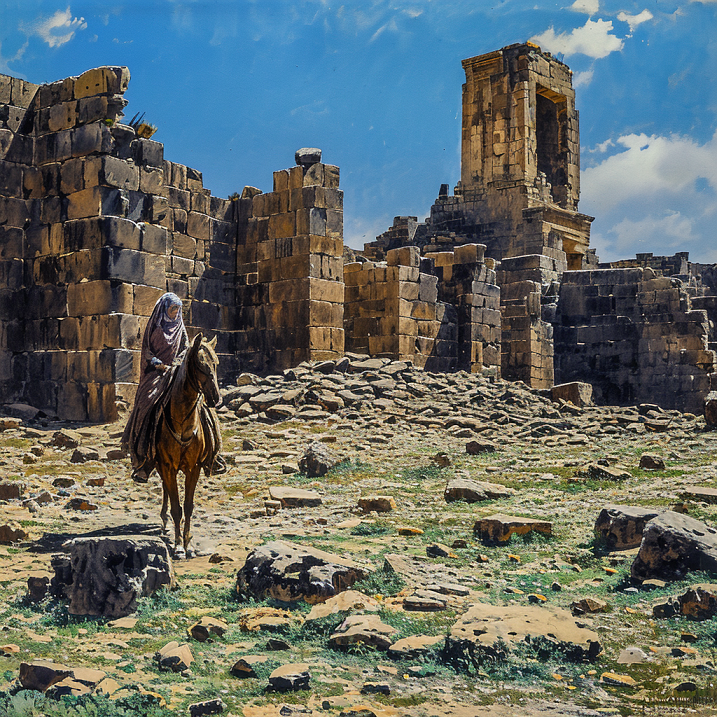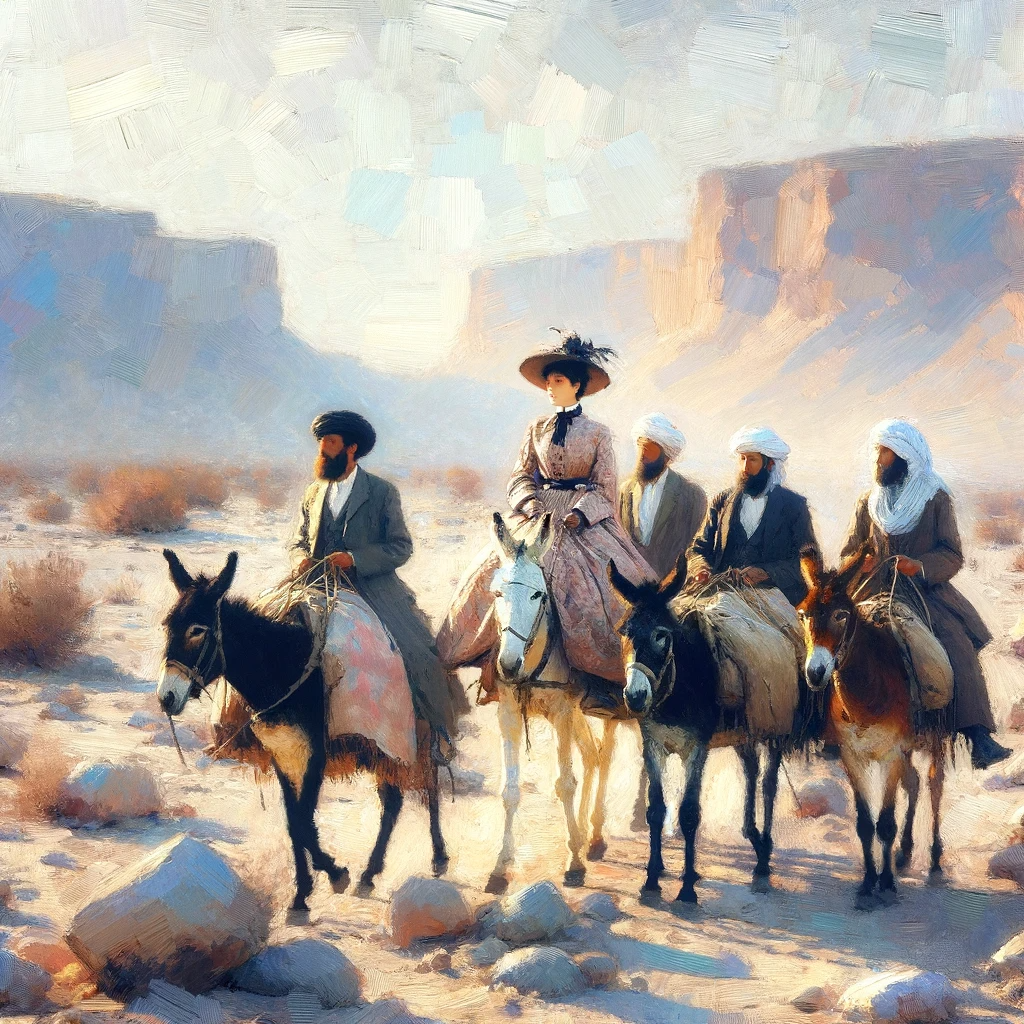In the early 20th century, Gertrude Bell, an indomitable explorer, archaeologist, and diplomat, embarked on a journey that would etch her name into the annals of Middle Eastern exploration and British colonial history. Her seminal work, “The Desert and The Sown,” provides a vivid account of her travels across the diverse landscapes of Greater Syria, Mesopotamia, Asia Minor, and Arabia. Bell’s detailed observations of the geography, cultures, and colonial dynamics of the region offer insights into her encounters with various tribes, including the Kurds, Armenians, and Bedouins. Through her eyes, we explore ancient cities such as Damascus, Aleppo, and Jerusalem, and examine the intricate tapestry of life in the desert and the sown.
Gertrude Bell’s Background
Gertrude Bell, born on July 14, 1868, in Washington, England, emerged as one of the most influential figures in the British imperial policy-making arena in the Middle East, particularly in what is now known as Iraq. Her vast array of talents and deep knowledge of the region’s languages, people, and politics enabled her to play a pivotal role in shaping the geopolitical landscape of the Middle East during the early 20th century.
Bell’s background was as diverse as the lands she would come to explore. She graduated from Oxford with first-class honours in Modern History, a testament to her intellectual prowess. Her passion for adventure and her formidable spirit led her beyond the confines of academic halls to the vast and complex tapestry of the Middle East. Her journeys were not mere travels; they were a series of detailed explorations that provided invaluable insights into the cultures, geographies, and politics of the Arab world.
“The Desert and The Sown,” published in 1907, stands as a monumental work within Bell’s extensive oeuvre. It chronicles her extraordinary travels across the Middle East, offering readers a window into the breathtaking landscapes, ancient civilizations, and vibrant cultures of the region. Bell’s unique perspective as both a woman and a Westerner in the Eastern lands during this period offers a nuanced view of the socio-political dynamics and colonial influences at play.
Gertrude Bell’s significance extends beyond her contributions as an explorer and writer. She was a central figure in British imperial politics, directly involved in the drawing of the borders that would define the modern state of Iraq. Her deep understanding of tribal dynamics and her relationships with key tribal leaders were instrumental in the establishment of the Hashemite dynasty in Jordan and Iraq. Bell’s legacy is multifaceted, reflecting her roles as an archaeologist, a linguist, an intelligence officer, and a diplomat. Her work, particularly “The Desert and The Sown,” continues to be a critical resource for historians, geographers, and anyone interested in the rich history and complexity of the Middle East.
Historical Context of the Middle East during Bell’s Travels
The early 1900s, the period during which Gertrude Bell embarked on her explorations, was a time of significant transition in the Middle East. The Ottoman Empire, which had ruled much of the region for centuries, was in decline, creating a vacuum that various powers, both internal and external, sought to fill. This era was marked by the stirrings of nationalism among Arab populations and increasing interest from European powers, notably Britain and France, in the strategic and economic potential of the region. Bell’s travels and writings provide a crucial snapshot of the Middle East at this pivotal moment, offering insights into the complex tapestry of tribal allegiances, the fading grip of Ottoman rule, and the nascent aspirations for Arab autonomy.
Gertrude Bell’s Role
Bell’s multifaceted role in the Middle East extended far beyond that of an observer or travel writer. Her unparalleled knowledge of the region, its languages, and its people positioned her as a key asset to British imperial interests. She was one of the few Westerners, and even fewer women, to travel extensively through the Arabian desert, engaging directly with tribal leaders and collecting intelligence that would prove invaluable to British policy. Her contributions were not limited to exploration; she played a direct role in the political machinations of the area, notably in the establishment of the modern state of Iraq. Her efforts in drawing the boundaries of the new country and in the selection of its king underscore her significant influence on the geopolitical realities of the Middle East.
Significance of the Work
“The Desert and The Sown” stands as a landmark in travel literature and an essential text for anyone seeking to understand the Middle East. Bell’s account transcends the typical travel narrative, offering a blend of adventure, scholarly research, and ethnographic study. Her vivid descriptions of landscapes, cities, and peoples provide a rich, multifaceted view of the region at a time of great change. Furthermore, her work has had a lasting impact on Middle Eastern studies, serving as a primary source for scholars and historians interested in the cultural, social, and political dynamics of the Arab world in the early 20th century. Through her writings, Bell has left an ineffaceable mark on the understanding of a region that continues to play a central role in global affairs.

Exploration vs. Colonization
Gertrude Bell’s narratives often straddle the fine line between exploration and colonization, reflecting the dual nature of her journey. She approached the Middle East with a profound sense of curiosity and a genuine respect for its peoples and cultures. Yet, as a British citizen deeply involved in the imperial project, her travels inevitably intersected with broader colonial ambitions. Bell’s detailed accounts, such as her visits to the majestic ruins of Palmyra, serve not only as explorations of ancient civilizations but also subtly underscore the British interest in the region’s archaeological and strategic value.
One of the most striking examples of this duality is Bell’s interactions with local leaders. Her meetings with influential tribal chiefs reveal her role as both a cultural ambassador and an agent of British influence. Through these encounters, Bell navigated the complexities of tribal politics and imperial interests, often facilitating the British government’s objectives while fostering mutual respect and understanding.
The Geography of the Middle East
Bell’s writings offer a vivid portrayal of the Middle East’s diverse geography, from the barren deserts of Arabia to the fertile plains of Syria. Her descriptions of the landscape are not merely observational; they delve into how the geography shapes the lives and cultures of its inhabitants. The contrast between the “desert” and the “sown” serves as a recurring theme, symbolizing the region’s environmental and cultural diversity.
For instance, Bell’s accounts of the Syrian steppes and the lush oases she encountered on her travels highlight the adaptability of the Middle Eastern peoples to their environment. Her observations on the Bedouin nomads, in particular, illuminate their profound connection to the desert and their ingenious adaptations to its harsh conditions. Conversely, her descriptions of agricultural practices in more fertile areas provide insight into the settled life of the region’s farmers, offering a glimpse into the daily rhythms and traditions that have been shaped by the land.
Cultural Insights and Encounters
Bell’s journey through the Middle East was marked by a deep engagement with its diverse cultural tapestry. Her detailed observations of the Kurds, Armenians, and various Arab tribes shed light on the rich mosaic of ethnic and religious identities that coexist within the region. Through her eyes, readers gain an intimate view of the social customs, traditions, and living conditions of the people she encountered.
Her account of visiting cities like Damascus and Aleppo is particularly illuminating. Bell describes the vibrant markets, ancient mosques, and bustling streets with a keen eye for detail, capturing the essence of urban life in the Middle East. These descriptions are complemented by her analysis of the social and political structures she observed, offering a nuanced understanding of how tribal affiliations and the remnants of Ottoman governance influenced local communities.
The Role of Women
As a woman navigating a predominantly male-dominated sphere, Bell’s reflections on the status and roles of women in the societies she visited add a unique dimension to her narrative. Her position allowed her to access spaces and conversations that were often closed to men, providing a rare glimpse into the lives of Middle Eastern women.
Bell’s encounters with women, from the seclusion of harems to the more public roles of women in Christian communities, highlight the varied experiences of women across different cultures and regions. Her observations on these differences, coupled with her own experiences as a Western woman in Eastern lands, offer a poignant commentary on gender roles and the limitations placed on women during her time.
Personal Reflections & Literary Style
Gertrude Bell’s “The Desert and The Sown” is celebrated not only for its rich ethnographic content but also for its compelling narrative style. Bell adeptly combines factual reporting with lyrical descriptions, transporting readers to the heart of the Middle Eastern landscapes and cities she explores. Her narrative is enriched by the use of personal diaries and letters, which lend an intimate and authentic voice to her account. This blend of personal reflection with detailed observation allows Bell to create a vivid tapestry of the places and people she encounters, making her work a standout piece of travel literature.
Bell’s descriptive prowess is particularly evident in her portrayals of the natural environment and architectural wonders. For example, her depiction of the ruins of Babylon not only conveys the historical significance of the site but also evokes a sense of awe at the ancient world’s grandeur. Similarly, her descriptions of Damascus’s bustling markets immerse the reader in the sensory experiences of the city, from the vivid colours of spices and textiles to the cacophony of vendors and shoppers.

Use of Personal Diaries and Letters
The inclusion of excerpts from Bell’s personal diaries and letters adds a layer of depth to her narrative. These personal insights reveal her inner thoughts, challenges, and the sheer exhilaration of discovery. They provide a glimpse into Bell’s resilience and determination as she navigated the complexities of travel in the Middle East, often breaking through societal and physical barriers that few Western women of her time dared to challenge.
Blend of Objective Observations with Subjective Experiences
While Bell’s work is grounded in careful observation and scholarship, it is her subjective experiences that imbue her narrative with a unique character. Her reflections on the landscapes, people, and cultures she encounters are interspersed with personal anecdotes and moments of introspection, offering readers a comprehensive view of her journey. This blend of objectivity and subjectivity allows Bell to present a nuanced perspective on the Middle East, one that recognises its beauty and complexity while also acknowledging the challenges and contradictions of the region.
Bell’s literary style, with its rich descriptions and personal reflections, makes “The Desert and The Sown” not just a document of historical and cultural significance but also a work of profound human insight and artistic merit. Through her writings, Bell invites readers to share in her journey of discovery, offering a window into the soul of the Middle East as seen through the eyes of one of its most passionate and insightful observers.
Influence on Travel Literature and Historical Perspectives
“The Desert and The Sown” has had a lasting impact on both travel literature and the study of the Middle East. Gertrude Bell’s work is not merely a record of her travels but a pioneering contribution to the genre of travel writing, especially as it pertains to the Arab world. Her meticulous observations, combined with a narrative style that is both informative and evocative, have inspired subsequent generations of travellers, writers, and scholars. Bell’s ability to capture the essence of the places and peoples she encountered has made her work an invaluable resource for those seeking a deeper understanding of the Middle East beyond the stereotypes and generalisations often portrayed in Western media.
Furthermore, Bell’s writings provide a critical primary source for historians and scholars of Middle Eastern studies. Her detailed descriptions of the social, cultural, and political landscapes of the early 20th century Middle East offer insights into a period of significant change and complexity. By documenting her encounters with various tribes, detailing the intricacies of local governance, and describing the ancient ruins of cities like Palmyra, Bell has contributed to a richer, more nuanced historical record of the region.
Gertrude Bell’s Legacy in Shaping British Policy and the Modern Middle East
Bell’s role in shaping the modern Middle East extends far beyond her contributions as a writer and explorer. As a political officer and advisor to the British government, she played a significant part in the drawing of the borders that defined the new state of Iraq. Her deep understanding of tribal dynamics, her relationships with key leaders, and her strategic insight were instrumental in the establishment of the Hashemite monarchy in Iraq and, by extension, the political configuration of the region.
Bell’s legacy is also evident in her contributions to the field of archaeology and her efforts to preserve the cultural heritage of the Middle East. As one of the founders of the Baghdad Archaeological Museum, she worked tirelessly to ensure that the region’s archaeological treasures remained in their country of origin, accessible to the people whose history they represent. This aspect of her work highlights her commitment to the preservation and appreciation of Middle Eastern cultures, contrasting with the often exploitative nature of colonial archaeology.
Contemporary Relevance
Today, the observations and analyses provided by Bell in “The Desert and The Sown” continue to be of relevance. Her accounts offer a historical perspective that can inform contemporary discussions about the Middle East, shedding light on the origins of current geopolitical, social, and cultural dynamics. As the region remains a focal point of global interest and conflict, Bell’s work serves as a reminder of the importance of understanding its complex history and the perspectives of its people.
Conclusion
Gertrude Bell’s “The Desert and The Sown” transcends the conventional boundaries of travel literature to provide a profound exploration of the Middle East’s geography, culture, and colonial dynamics during a pivotal era. Through her meticulous observations and engaging narrative style, Bell offers readers a window into the diverse landscapes and rich cultural tapestry of the region, underscored by her own unique experiences and reflections.
Her work not only enriched the genre of travel writing but also contributed significantly to historical and cultural studies of the Middle East, providing insights that remain relevant to this day. Bell’s legacy, marked by her influential role in shaping the modern Middle East and her contributions to preserving its cultural heritage, continues to inspire scholars, travellers, and readers alike. “The Desert and The Sown” stands as a testament to Bell’s indelible impact, offering a timeless perspective on a region that remains at the heart of global affairs.

